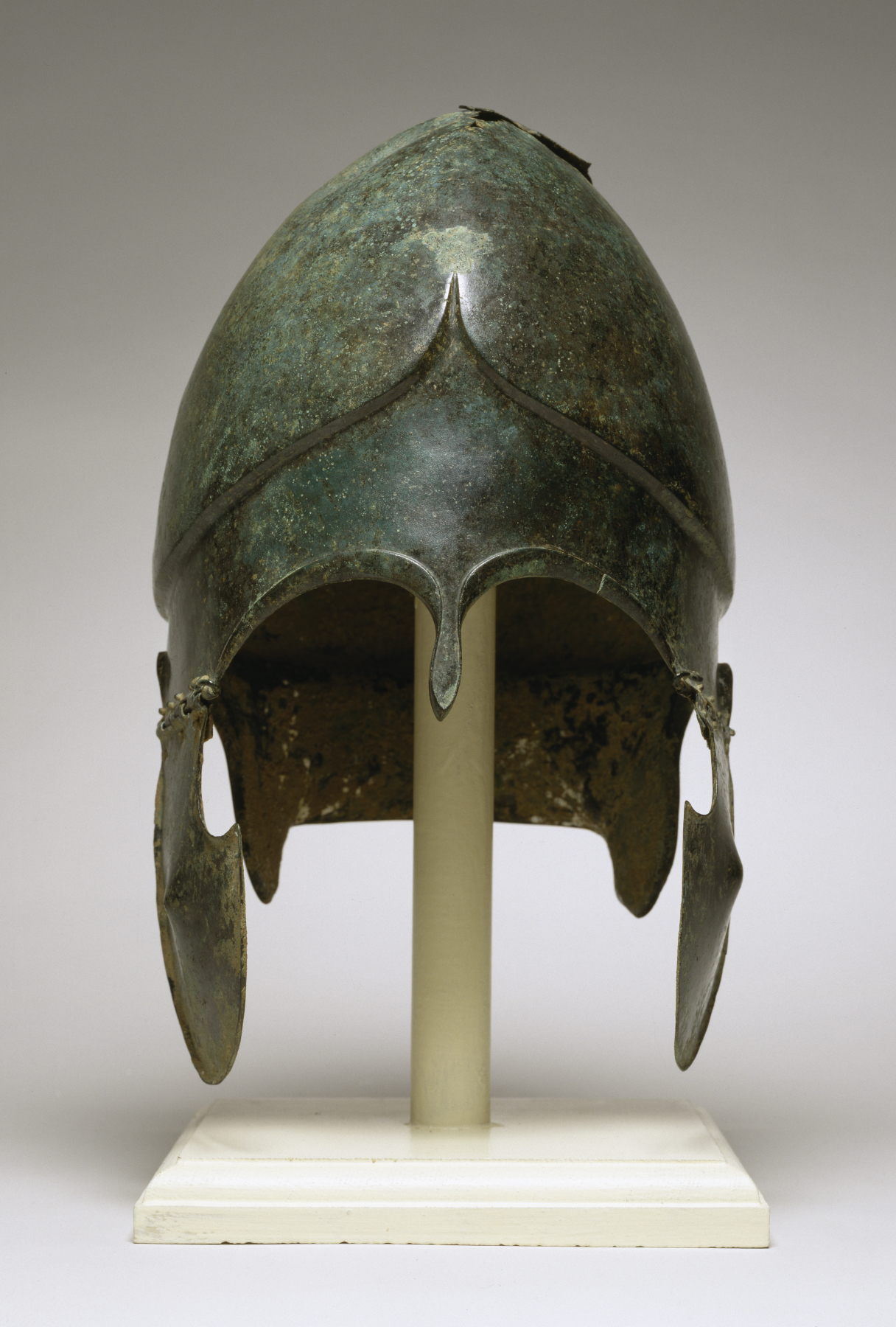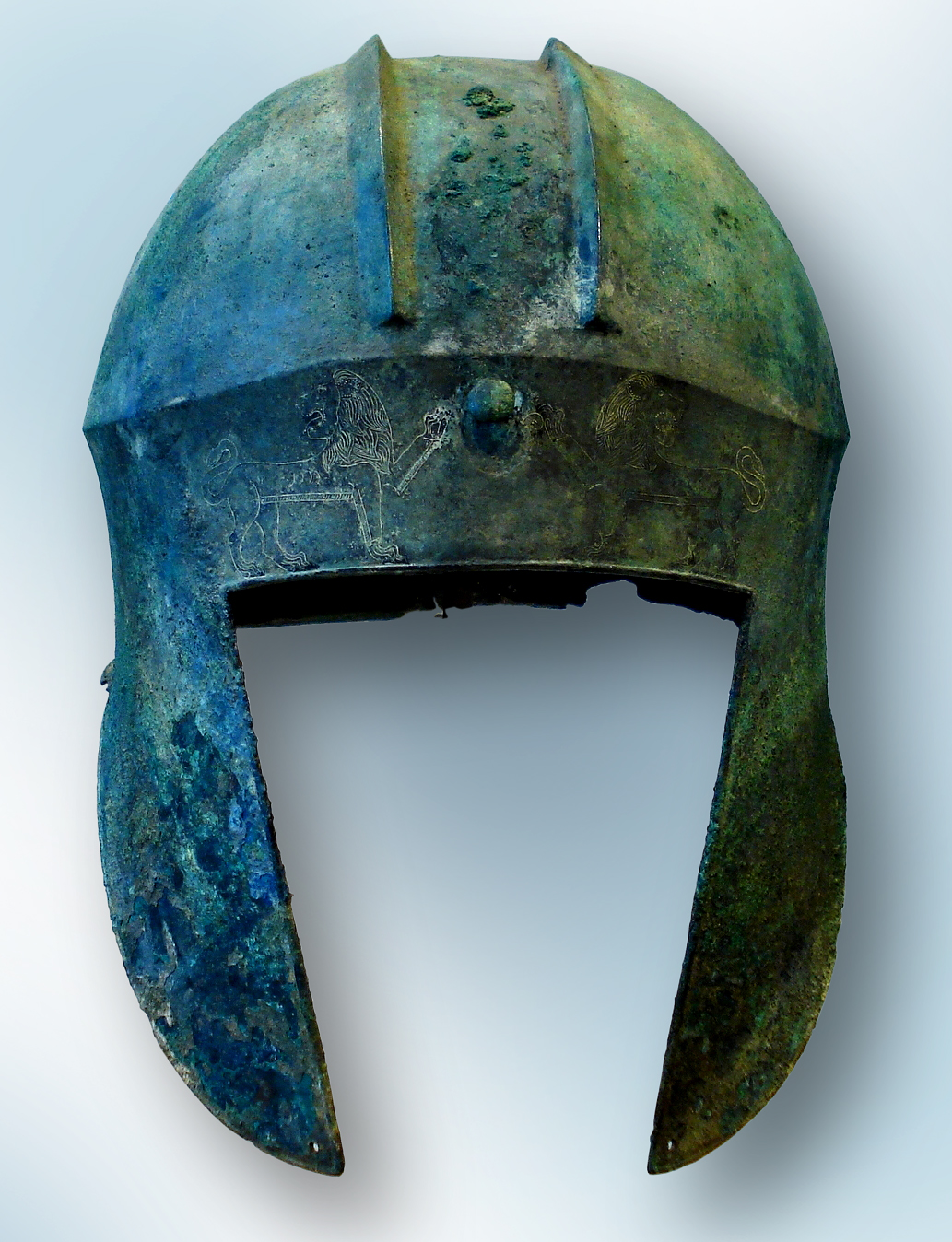|
Greek Helmet (other)
{{disambig ...
Greek helmet may refer to any of the following: * Attic helmet * Boar's tusk helmet * Boeotian helmet * Chalcidian helmet * Corinthian helmet * Illyrian type helmet * Kegelhelm * Phrygian type helmet * Pileus (hat) The pileus (, ; also or in Latin) was a brimless felt cap worn in Ancient Greece, Etruria, Illyria (Pannonia), later also introduced in Ancient Rome. The pileus also appears on Apulian red-figure pottery. The pilos together with the petasos ... [...More Info...] [...Related Items...] OR: [Wikipedia] [Google] [Baidu] |
Attic Helmet
The Attic helmet was a type of helmet that originated in Classical Greece and was widely used in Italy and the Hellenistic world until well into the Roman Empire. Its name is a modern historiographic convention: "Terms such as Illyrian and Attic are used in archaeology for convenience to denote a particular type of helmet and do not imply its origin". The Attic helmet was similar to the Chalcidian helmet but lacked a nose guard. Although in Greece itself its use was not as widespread as the Corinthian or Phrygian types, the Attic helmet became very popular in Italy, where most examples have been found. Many Italian peoples used variations of the attic helmet, but archaeologically it has been especially prominent in Samnite and Lucanian burials and their associated art (frescos etc.). As an artistic motif, variations of the Attic helmet long outlasted other contemporary helmet types, being used to impart an archaic look to depictions of generals, emperors and Praetorians throu ... [...More Info...] [...Related Items...] OR: [Wikipedia] [Google] [Baidu] |
Boar's Tusk Helmet
Helmets using ivory from boars' tusks were known in the Mycenaean world from the 17th century BC ( Shaft Graves, Mycenae) to the 10th century BC (Elateia, Central Greece). The helmet was made through the use of slivers of boar tusks which were attached to a leather base, padded with felt, in rows. A description of a boar's tusk helmet appears in book ten of Homer's ''Iliad'', as Odysseus is armed for a night raid to be conducted against the Trojans. Fragments of ivory which might have come from helmets of this kind have been discovered on Mycenaean sites (at Dendra, for instance, fragments were found alongside the bronze panoply excavated in 1960) and an ivory plaque, also from a Mycenaean site, represents a helmet of this kind. Although they would not provide protection as good as that of a metal helmet, they may have been worn by some leaders as a status symbol, or a means of identification. Homer specifies that the helmet given by Meriones to Odysseus was an heirloom, p ... [...More Info...] [...Related Items...] OR: [Wikipedia] [Google] [Baidu] |
Boeotian Helmet
The Boeotian helmet was a type of combat helmet used in Ancient Greece during the classical and Hellenistic periods, as well as in Ancient Rome; it possibly originated in the Greek region of Boeotia. Characteristics The Boeotian helmet was modelled on the shape of a folded-down Boeotian variant of the ''petasos'', a type of Greek sun hat, usually made of felt. As an open helmet, it allowed good peripheral vision and unimpaired hearing. It had a domed skull surrounded by a wide, flaring, down-sloping brim. The brim came down at the rear to protect the back of the neck, projected forward over the forehead and was worked into a complex shape at the sides, with downward pointing folds affording some lateral protection to the face. A long falling plume was sometimes attached to this type of helmet. The need for unimpeded vision and good hearing was particularly acute for cavalrymen, therefore this type of helmet was used primarily by mounted troops. This type of helmet was beaten f ... [...More Info...] [...Related Items...] OR: [Wikipedia] [Google] [Baidu] |
Chalcidian Helmet
A Chalcidian helmet or Chalcidian type helmet was a helmet made of bronze and worn by ancient warriors of the Hellenic world, especially popular in Greece in the fifth and fourth centuries BC. The helmet was also worn extensively in the Greek (southern) parts of Italy in the same period. Terminology The helmet is so-called because it was first, and is most commonly, depicted on pottery once thought to derive from the Euboean city of Chalcis. In fact, it is not known whether the helmet originated in Chalcis; indeed, it is not even known whether the pottery in question was Chalcidian. Description The helmet appears to have been a development of the Corinthian helmet, its improvements in design giving the wearer better hearing and vision, resulting in a lighter and less bulky helmet. It consisted of a hemispherical dome, and below that, generally inset from the top dome, a pair of cheek pieces and a neck guard, with a substantial loop on either side for the wearer's ears. In t ... [...More Info...] [...Related Items...] OR: [Wikipedia] [Google] [Baidu] |
Corinthian Helmet
The Corinthian helmet originated in ancient Greece and took its name from the city-state of Corinth. It was a helmet made of bronze which in its later styles covered the entire head and neck, with slits for the eyes and mouth. A large curved projection protected the nape of the neck. Out of combat, a Greek hoplite would wear the helmet tipped upward for comfort. This practice gave rise to a series of variant forms in Italy, where the slits were almost closed, since the helmet was no longer pulled over the face but worn cap-like. Although the classical Corinthian helmet fell out of use among the Greeks in favour of more open types, the Italo-Corinthian types remained in use until the 1st century AD, being used, among others, by the Roman army. Physical evidence Apparently (judging from artistic and archaeological evidence) the most popular helmet during the Archaic and early Classical periods, the style gradually gave way to the more open Thracian helmet, Chalcidian helmet ... [...More Info...] [...Related Items...] OR: [Wikipedia] [Google] [Baidu] |
Illyrian Type Helmet
The Illyrian type helmet (or Greco-Illyrian type helmet) is a style of bronze helmet, which in its later variations covered the entire head and neck, and was open-faced in all of its forms.. It originated in Peloponnese, ancient Greece, and was developed during the 8th and 7th centuries BC (700–640 BC).. Accurate representations on Corinthian vases are sufficient to indicate that the Illyrian type helmet was developed before 600 BC.. The helmet is named today as ''Illyrian type'' for convenience due to many initial archaeological discoveries coming from the region of Illyria.Naming conventions and typology of ancient helmets are of modern origin and do not reflect contemporaneous usage. ( Archaeology According to archaeological evidence, the Illyrian type helmet evolved from the Kegelhelm (or Kegel type) of the Archaic Period found in Argos. The earliest Illyrian type helmets were developed in a workshop located in the northwestern Peloponnese (possibly Olympia), although ... [...More Info...] [...Related Items...] OR: [Wikipedia] [Google] [Baidu] |
Kegelhelm
The Kegelhelm (German German(s) may refer to: * Germany (of or related to) **Germania (historical use) * Germans, citizens of Germany, people of German ancestry, or native speakers of the German language ** For citizens of Germany, see also German nationality law **Ge ...: "cone helm") or Kegel type is a type of helmet. It is an open-faced helmet of roughly conical shape, sometimes with extensions at the sides to protect the cheeks, or a crest-holder on top. It was made of bronze, sometimes in several pieces. It was the progenitor of many Greek helmets,Peter Connoly, ''Greece & Rome at War'', , p.60: "There are several forms of Greek helmet but they all seem to have evolved from two prototypes - the Kegel and the primitive corinthian" especially the "Illyrian" type helmet. It did not outlast the eighth century BC. Related reading *Peter Connoly, Greece & Rome at War, References External linksA Kegelhelm from the 8th century B.C. Ancient Greek helmets {{AncientG ... [...More Info...] [...Related Items...] OR: [Wikipedia] [Google] [Baidu] |
Phrygian Type Helmet
The Phrygian helmet, also known as the Thracian helmet, was a type of helmet that originated in ancient Greece and was widely used in Thrace, Dacia, Magna Graecia and the Hellenistic world until well into the Roman Empire. Characteristics The names given to this type of helmet are derived from its shape, in particular the high and forward inclined apex, in which it resembles the caps (usually of leather) habitually worn by Phrygian and Thracian peoples. Like other types of Greek helmet, the vast majority of Phrygian helmets were made of bronze. The skull of the helmet was usually raised from a single sheet of bronze, though the forward-pointing apex was sometimes made separately and riveted to the skull. The skull was often drawn out into a peak at the front, this shaded the wearer's eyes and offered protection to the upper part of the face from downward blows. The face was further protected by large cheekpieces, made separately from the skullpiece. Sometimes these cheekpiec ... [...More Info...] [...Related Items...] OR: [Wikipedia] [Google] [Baidu] |




.jpg)

